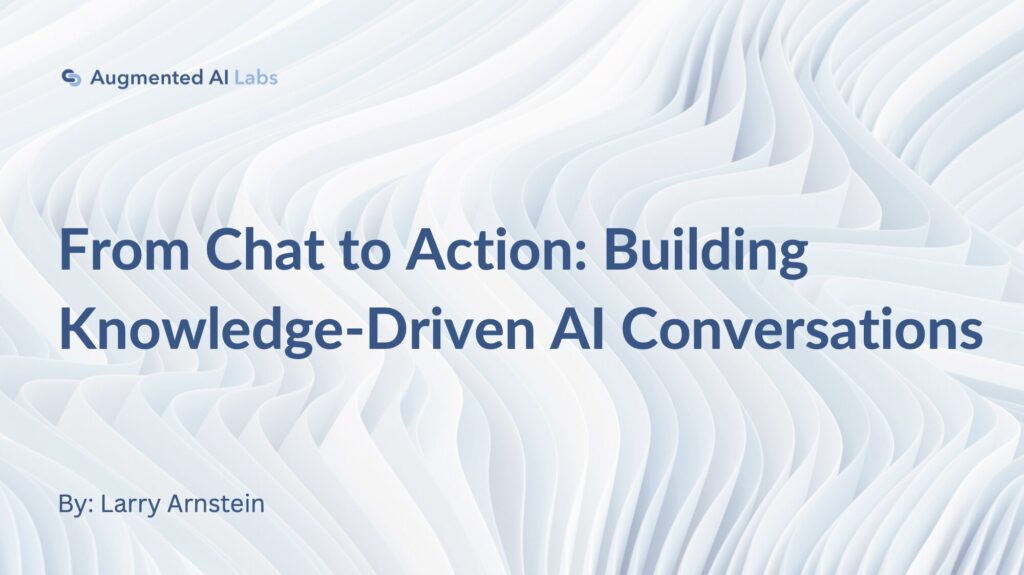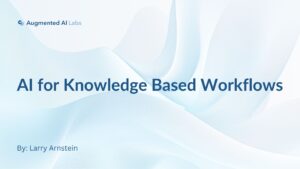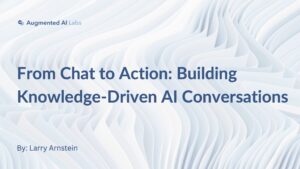Good Chat — A Recipe
You’ve spent years investing in content marketing to attract prospects and differentiate your business. And it works. Prospects come to your site, consume content and get interested. Then, uh-oh, they have a question. Now what? Schedule a meeting? That’s a big expensive leap from self-serve to white glove while still very early in the mutual qualification process. This transition is costly for the firm and, worse, it is most likely inconvenient for the prospect. Really, they just have a couple of questions.
Surely it is possible for AI Chat to fill that gap — to answer questions succinctly and accurately, learn a bit more about the prospect, and move them further into the funnel. Well, good AI Chat turns out to be difficult for two reasons:
AI Chat is only as good as the underlying knowledge base
A natural conversation flow requires more than simply answering questions
At Augmented AI Labs we have developed an integrated knowledge management and chat solution that solves these two problems, resulting in a reliable, helpful option for engaging early stage prospects.
Content is not Knowledge
Most current chat platforms offer a chat experience that uses legacy content such as blogs, web pages, whitepapers, video transcripts, and other forms of documentation as the underlying knowledge base. At first, it may seem to work. But then you notice something: out-of-date information shows up, you get different or contradictory answers to the similar questions, or you can’t get an answer even though you know that it’s in there. If you want to know more about why these things happen, read our last blog ‘The Shift From Knowledge to Content’. But the bottom line is this: building an externally facing AI Chat experience for inbound prospects on a black-box knowledge base filled with legacy content is a recipe for failure.
Good News, Bad News, Good News
The good news is that your legacy content is valuable. It contains a ton of useful knowledge that can be extracted using AI. The bad news is that it requires some ongoing effort and attention to curate your knowledge going forward. However, the real good news is that the return on investment for creating and curating a high quality knowledge base in the GenAI era is big, and goes well beyond just enabling high quality Chat for inbound prospects.
The approach we have taken to creating a knowledge base that can be easily curated and managed by non-technical subject matter experts in your firm is in the form of questions and answers. We call them “Known Good Answers” or KGAs. Here is a KGA entry from our own knowledge base:

If you think of all the questions that your prospects might have about your firm — about how you do business, the market space, and the services or products you offer — the number of KGAs could be in the hundreds or thousands. If someone gave you a spreadsheet with a thousand KGAs you might consider that to be unmanageable. But with the right tools it can be easy, collaborative, and even fun to create something you’ve never had before: a well organized knowledge base that represents the core intellectual property of your company that is usable in many compelling ways.
Unlike the unsuccessful legacy-content black-box approach, Chat based on KGAs is accurate. There are deep technical reasons why KGAs are better than old content for supporting Chat, but the most important difference is that with KGAs and our KGA Manager tool, your experts have full visibility and control over the knowledge base and by extension, the Chat experience.
The KGA Manager (KGAM)
Managing thousands of KGAs in a spreadsheet would be nearly impossible. For example, how would you find two KGAs that address similar questions perhaps in complementary or contradictory ways so that you can merge or correct them? This would be difficult in a spreadsheet, but it is very easy to do in Augmented AI Labs KGA Manager (KGAM). I’ll explain one really cool feature of the KGAM called “Pivot”, and you can get a full demonstration video KGAM here.
The KGAM screenshot below shows that, with conventional filtering, I can quickly find all KGAs that contain the text “opportunity”. The first matching KGA has the question “What is an Opportunity Assessment?”.
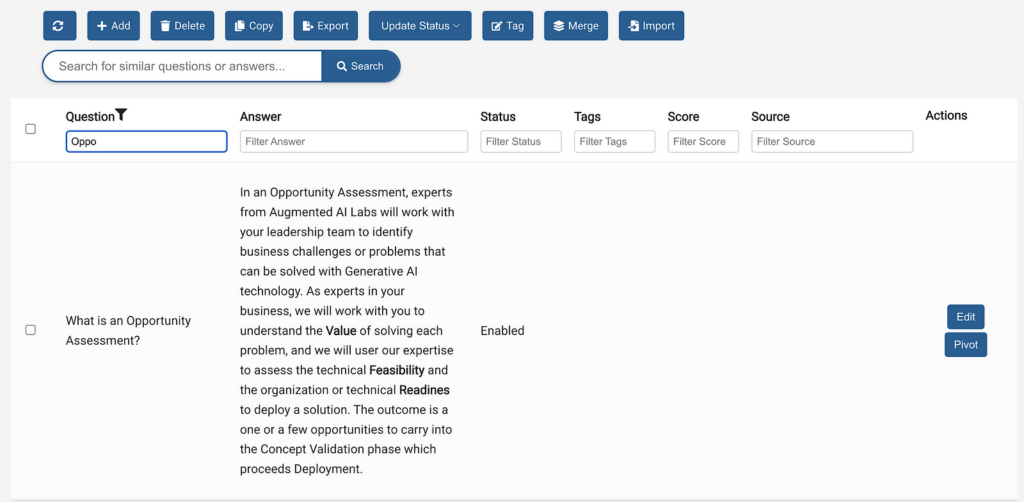
As a knowledge manager I might want to know if I have other KGAs that touch on this concept. For that, we have a button called “Pivot”. If I click that button, all of my KGAs will be sorted in order of how similar they are to the pivoted KGA. Here is the result:
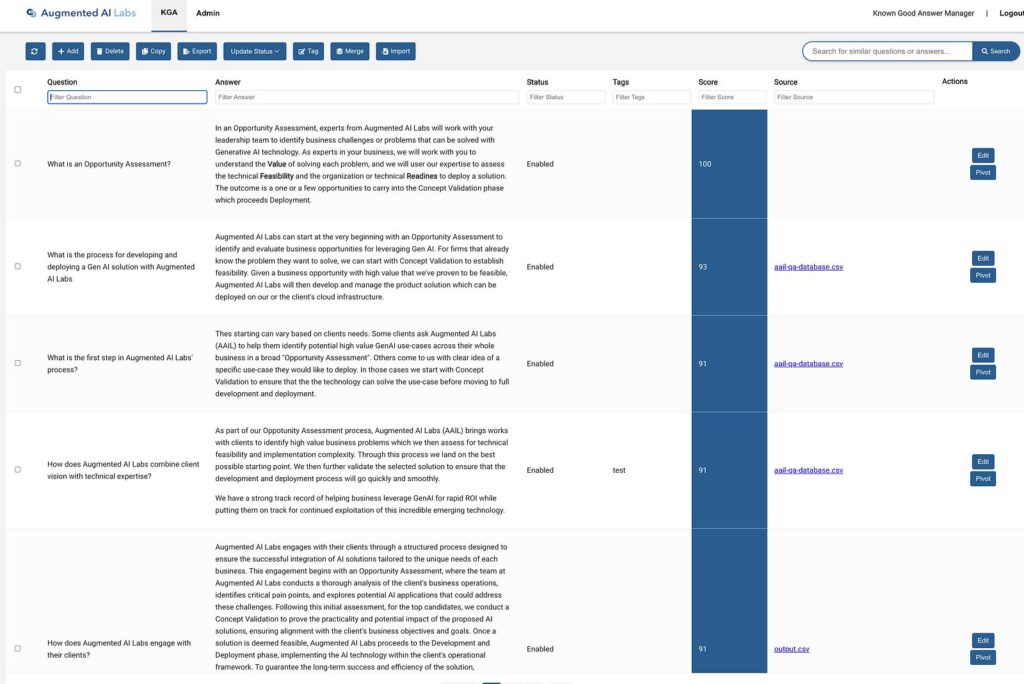
The pivoted KGA goes to the top with a match score of 100%, and now I see all of the other KGAs that are similar to the top one. These KGAs may not even use the words “Opportunity Assessment”. Pivot sorts the KGAs based on semantic similarity using AI, not based on keyword matching.
Some overlap or duplication between KGAs is no problem, but certainly we don’t want contradictory information. By selecting these similar KGAs and clicking the “Consolidate” button, the KGAM uses AI to suggest revised KGAs that address any conflicts, while ensuring no loss of information. With just a few clicks the expert can ensure the quality of the KGAs around this topic.
How KGAs enable Natural Conversations
When a Chat user asks a question, our chat platform fetches potentially relevant KGAs from the KGAM. Those fetched KGAs are presented, along with the original question, to the GenAI model to generate a response. By design, we fetch a larger number of KGAs than we really need. We do this for two reasons: first, the most useful KGA is not always the highest score and second, the additional KGAs play a key role in driving a smooth natural dialog. Without getting too deep into prompt engineering, we tell the model to do these things:
Answer the question using the available KGAs if possible, otherwise offer a specific follow-up action (submit a question, offer a meeting, etc.)
Keep the answers relatively short and, if and only if there is enough additional information in the fetched KGAs to do so, offer to elaborate. (we don’t want to offer to elaborate then fail to have any additional information)
Finally, suggest one or two questions that the user might want to ask that can be answered by fetched KGAs not used in the above response. The purpose of these questions is to help the dialog branch out into different directions. (Like above, the pre-fetched KGAs are key because we don’t want to suggest questions then fail to be able to answer them)
This seems like a magic formula for driving very smooth conversations. First, we don’t overwhelm the user with every detail in the first response. By keeping it short and asking if they want more, “yes” is typically all the user needs to type to keep the dialog going! Even ‘y’ would do!
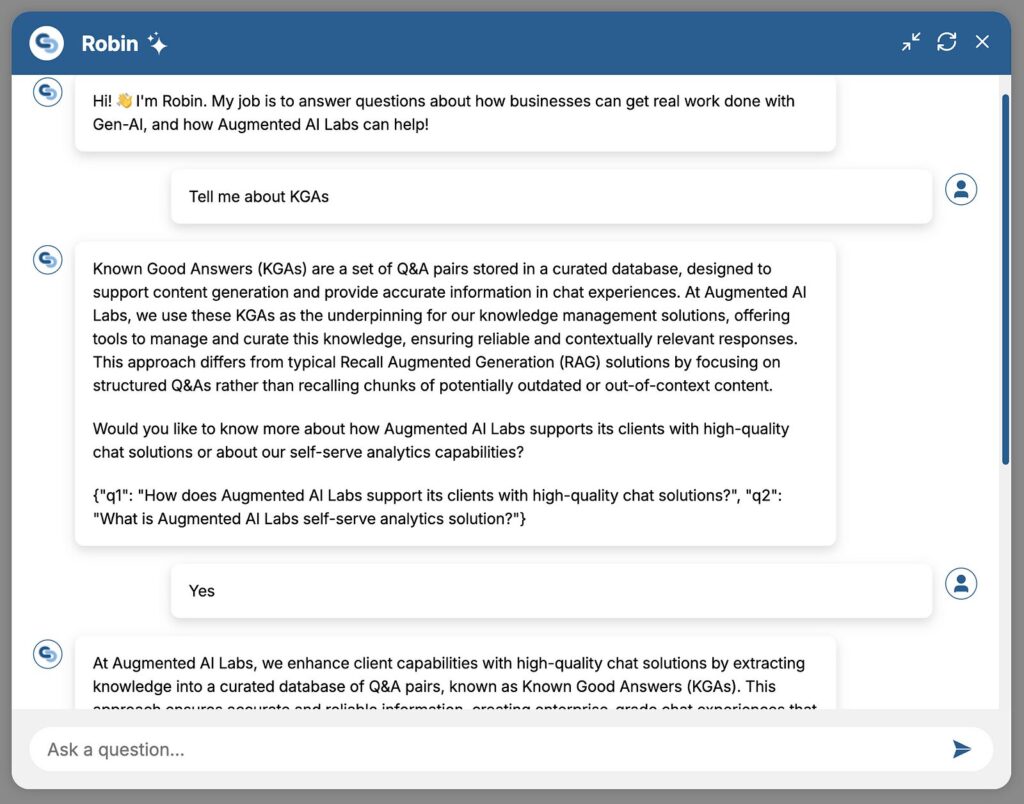
Finally, the suggested additional questions are presented to the user as buttons separate from the dialog response, allowing us to introduce new ideas and keep the user engaged without them having to type anything. Here is an example of how that looks in Robin (replace when we get the buttons integrated).
Improving the Knowledge Base
The Augmented AI Labs KGAM is integrated with our Chat application to track commonly asked questions, and more importantly, to capture questions that could not be fully answered by the information contained in the KGA. These questions can easily be added to the knowledge base with expert answers. With modest use, you will quickly cover the landscape of questions that your clients are asking.
Knowledge v. Content in the GenAI Era
Before the advent of GenAI, marketing departments invested in content creation with significant human effort. The world still needs content, and it will still take some human effort to produce high quality, but GenAI can do much of the heavy lifting. After all, Chat is just a form of content that just happens to be dynamically generated from a KGA knowledge base. As it turns out, other forms of content can also be generated from KGAs. For example, in KGAM, by selecting the top matching KGAs to the “what is an opportunity assessment?” question above, I was able to generate the following social media post with just one click:
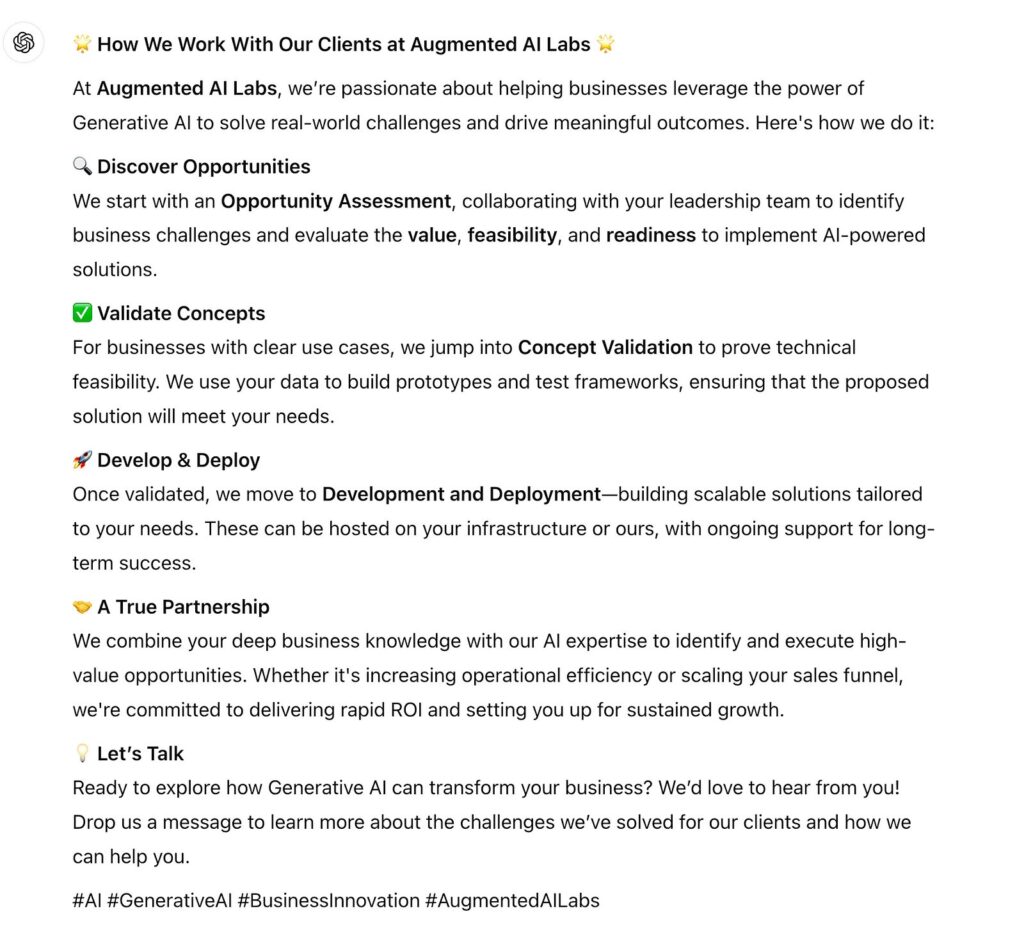
By shifting a fraction of your content production investment to knowledge management, you can drive high quality chat for inbound prospects while transforming your whole approach to high quality content generation.
Legacy Content v KGAs as Knowledge Base for Chat and other GenAI applications
Imagine that a speciality financial services company has created marketing content over several years to educate potential clients and establish credibility. This published information becomes increasingly out-of-date or incorrect as time passes and laws, regulations, or market conditions change. Fortunately, readers of old content can see the publication date and take some responsibility for understanding the implications. So no harm done. Not so for chat. If a chat application cherry picks factoids from legacy content, the chat user can no longer apply that same judgement and would naturally expect the information to be up-to-date and accurate.
Another challenge is context. The way chat systems use existing content is to literally chop it up into pieces called “chunks” (yes that is the technical term for it). Those chunks are then stored in a way that is easy to retrieve based on “semantic similarity”. The problem is that each of these chunks was never intended to be consumed out of context. To illustrate the difference between KGAs and legacy content as a knowledge base, consider this article published by Vantage IRA, a customer of Augmented AI Labs:
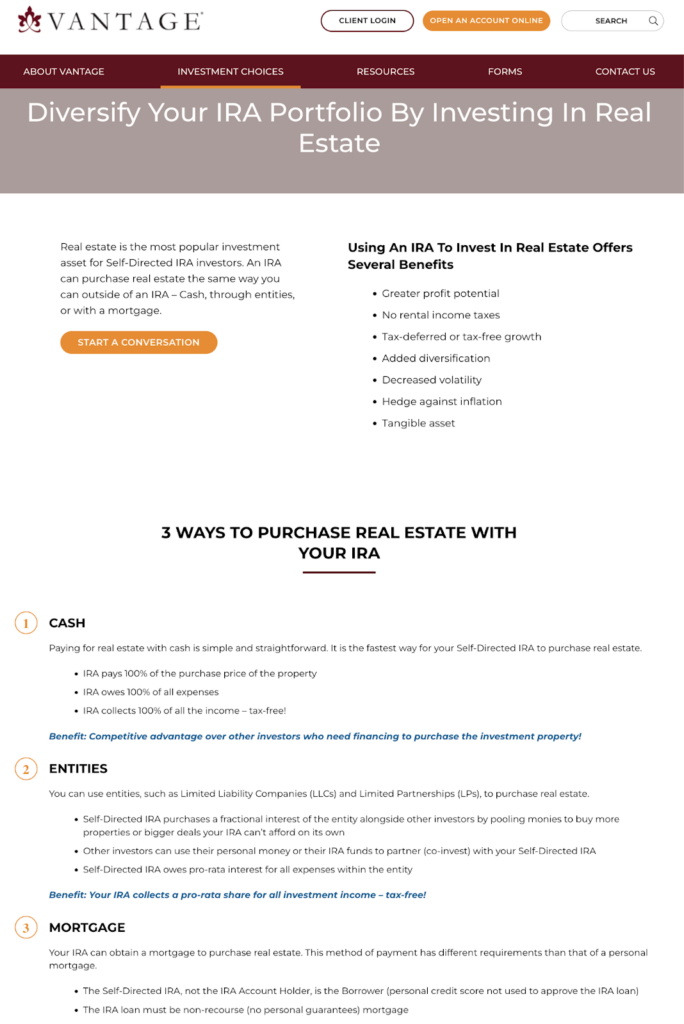
With an AI tool, in this case Claude, it is easy to convert into this article into a set of KGAs, as follows:
Q: What are the three main ways to pay for real estate with a Self-Directed IRA?
A: The three main ways are cash, entities (like LLCs and LPs), and mortgages.
Q: How does paying cash for real estate with a Self-Directed IRA work?
A: With cash purchases, the IRA pays 100% of the purchase price and all expenses, but also collects 100% of all income tax-free. This method provides a competitive advantage over investors who need financing because it is simpler for the seller.
Q: Can you partner with other investors when buying real estate with a Self-Directed IRA?
A: Yes, through entities like LLCs and LPs. Your IRA can purchase a fractional interest alongside other investors who can use either personal money or their own IRA funds. Expenses and income are shared proportionally based on ownership percentage.
Q: What are the key requirements for getting a mortgage through a Self-Directed IRA?
A: The key requirements are:
– The IRA itself must be the borrower, not the account holder
– The loan must be non-recourse (no personal guarantees)
– Down payments typically range from 30-50%
– The property must generate rental income to cover the mortgage
– The IRA is responsible for 100% of expenses and receives 100% of income
Q: What’s the main advantage of using a mortgage with a Self-Directed IRA?
A: The main advantage is leverage – your IRA savings can be used to purchase higher-priced properties or multiple properties that would otherwise be out of reach.
Q: Can you personally use the real estate purchased through your Self-Directed IRA?
A: No, you cannot personally use the property as a residence or vacation home, as this would be considered self-dealing. All real estate purchases must be strictly for investment purposes.
Q: What’s the main benefit of using cash to purchase real estate through an IRA?
A: The main benefit is having a competitive advantage over other investors who need financing, as cash purchases can be completed more quickly and straightforwardly.
Q: What’s the main benefit of using entities (LLCs/LPs) to purchase real estate through an IRA?
A: The main benefit is the ability to pool money with other investors to access larger or more numerous properties that your IRA couldn’t afford on its own, while still collecting tax-free income on your pro-rata share.
Now, consider what happens when a user asks “what are the various ways to invest in real estate with a self-directed IRA?”. To adequately answer this question from the legacy content, we would have to find and load the entire article. But that is not what happens. In practice, the article will be stored in chunks and the seemingly relevant chunks will be loaded which may or may provide a complete answer. And, questions may not be semantically similar to chunks of text even if a particular chunk happens to contain a partial answer to the question.
But in the KGA case, we are searching for questions with questions, and in this case, we will get a very close match. Furthermore, our question will likely match many of the related KGAs as well, supporting the natural dialog approach that we have developed.
Now imagine that Vantage wants to add a fourth way to invest in real estate. With legacy content they would have to edit and republish the original article and hope for the best. In the KGA Manager you would just edit one KGA and add one new KGA to explain the new investment option. Because each KGAs can stand alone (the KGA meaning is not dependent on any other context), there is no risk of taking anything out of context.
About Larry Arnstein
Larry brings broad technical and business experience to Augmented AI Labs. Larry joined the Augmented AI Labs team after a long entrepreneurial career that included helping lead Impinj to IPO in 2016 as a member of the executive leadership team, followed by the acquisition of Xnor.ai by Apple in 2019 where he was head of market and product strategy. Larry then left Apple to become the CTO and co-founder of AirTerra, a retail supply chain solution provider that was acquired by American Eagle Outfitters in 2021.
About Augmented AI Labs
Augmented AI Labs is a leading provider of AI-driven workflow solutions aimed at enabling businesses to optimize the key operational aspects that bring value to their clients. With Augmented AI Labs, you get more than just an AI service provider; you get a partner committed to your business’s success. We strive to make AI accessible, understandable, and beneficial for all businesses, regardless of size or industry.
Our AI development team is ready to help your business at every step. We’ll guide you from planning to launch, and from training to support. Whether it’s integrating process automation or conversational AI, you can think of us as a dedicated AI partner.

